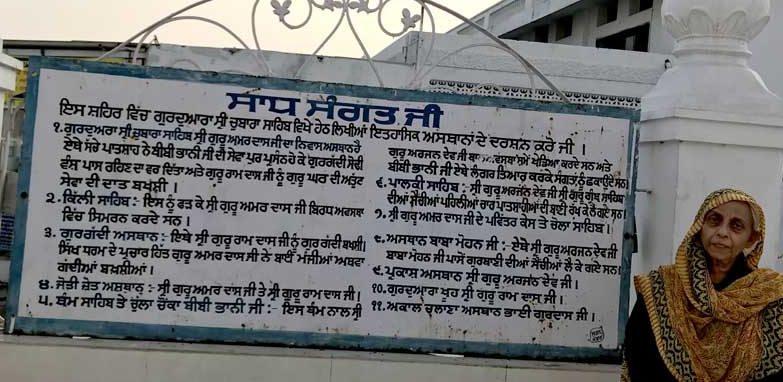Guru Amar Das shows the path to spiritually prepare for our final journey
This is a rarity in Guru Granth Sahib that you must know. Guru Amar Das breathed his last at 95 years, in Goindwal Sahib, on 1 September 1574 and the Bani of Ramkali Sadd in Guru Granth Sahib provides vital historical details. The Shabad of Ramkali Sadd, giving a graphic description of the passing away of the Third Master -Guru Amar Das, was revealed neither by the Gurus or Bhagats, but by Baba Sundar Ji, the great-grandson of Guru Amar Das, who was the son of Guru Sahib’s grandson, Anand. This is a rarity in Guru Granth Sahib explains the spiritually inclined author Bhupinder Singh Houston. Reading and imbibing this over and over again will help us craft our preparation for the end of our life’s journey, says the author.
![This is a rarity in Guru Granth Sahib that you must know. Guru Amar Das breathed his last at 95 years, in Goindwal Sahib, on 1 September 1574 and the Bani of Ramkali Sadd in Guru Granth Sahib provides vital historical details. The Shabad of Ramkali Sadd, giving a graphic description of the passing away of the Third Master -Guru Amar Das, was revealed neither by the Gurus or Bhagats, but by Baba Sundar Ji, the great-grandson of Guru Amar […]](https://www.theworldsikhnews.com/wp-content/uploads/2020/10/Guru-Amardas-Ji-360x266.jpg)
THE FIFTH MASTER GURU ARJAN DEV COMMISSIONED BABA SUNDAR JI, a great-grandson of the Third Master -Guru Amar Das, who was present at Goindwal Sahib at the time of departure of Guru Amar Das, to pen the eye-witness account. This writing is titled Sadd – Punjabi word for a call or summon. Baba Sundar Ji recaptures it in this six stanza verse -the instructions Guru Sahib gave to members of his family and his followers, along with the planning of Guruship.
These directives were given by Guru Sahib at the ripe old age of 95 years, just before he passed away. Guru Amar Das tells them not to weep and wail for him, nor to perform the customary mourning rites. Since death is an opportunity for the individual soul to get united with the Supreme Soul, it is not a moment for lament. The Bani of Guru Granth Sahib lays down clear guidelines on how to take care of our responsibilities and duties before departure from this world as well as how to conduct services in honour of the deceased.

Significantly, this Bani is an eye witness account of the time of death of the Third Master Guru Amar Das and anointing of Guru Ram Das as the successor Guru.
Interestingly, this composition is posited in Guru Granth Sahib following the composition of Anand Sahib by Guru Amar Das, thus underscoring their close relationship. Legend has it that Anand Sahib -The Song of Eternal Bliss was revealed at the time of the birth of Guru Sahib’s son -Anand. This is sung during sad and happy times, life and death, extolling the concept of living as enshrined by Akalpurakh -God Almighty.

The title Sadd of this composition is an indicator of the summons to Guru Amar Das from the Almighty. So, the title can be translated as “The Call of Death”. Originally, the term Sadd was used to denote songs addressed by a lover to his beloved, expressing his heart`s anguish. Now let us look at the unfolding of the event.
Guru Sahib called the gathering of family and the Sangat -followers. After everyone was seated, Guru Amar Das got down from his seat and placed Bhai Jetha Ji there.
This is a significant piece of authentic history, and well preserved for posterity, unaltered. It defines the Dos and Don’ts for the family of the departed soul. It is a composition that should be read, studied and analyzed over and over as it will help us craft our own preparation for the end of life journey as well.
On Guru Sahib’s direction, Bhai Budha applied the customary tilak on the forehead of Bhai Jetha Ji. Then the spiritual sovereignty was passed on to Bhai Jetha Ji, whom Guru Amar Das renamed as Guru Ram Das. Everyone joined in the rejoicing except Mohan the eldest son of Guru; who resented it feeling that being the biological heir –son, he was being deprived of his rightful succession.

The stanza-wise commentaries of the composition with extracts are as under:
Stanza 1- The concluding lines are:
“ਆਇਆ ਹਕਾਰਾ ਚਲਣਵਾਰਾ ਹਰਿ ਰਾਮ ਨਾਮਿ ਸਮਾਇਆ ॥
ਜਗਿ ਅਮਰੁ ਅਟਲੁ ਅਤੋਲੁ ਠਾਕੁਰੁ ਭਗਤਿ ਤੇ ਹਰਿ ਪਾਇਆ ॥੧॥”
Translation: And when the call came for Him to depart, He merged in the Name of the Lord. Through devotional worship in this world, the imperishable, immovable, immeasurable Lord had been found (by Guru Amardas). ||1||
Commentary: The scenario of the call to return or the summons is described. Guru Ji willingly accepted the call and prepared the execution plan without any delay. In the earlier lines, Sundar Ji has said that by the Grace of Guru Nanak and Guru Angad, Guru Amar Das had obtained the supreme status.
Stanza 2- The first lines are:
“ਹਰਿ ਭਾਣਾ ਗੁਰ ਭਾਇਆ ਗੁਰੁ ਜਾਵੈ ਹਰਿ ਪ੍ਰਭ ਪਾਸਿ ਜੀਉ ॥
ਸਤਿਗੁਰੁ ਕਰੇ ਹਰਿ ਪਹਿ ਬੇਨਤੀ ਮੇਰੀ ਪੈਜ ਰਖਹੁ ਅਰਦਾਸਿ ਜੀਉ ॥”
Translation: The Guru gladly accepted the Lord’s Will, and so Guru easily reached the Lord God’s Presence. The True Guru prays to the Lord, “Please, save my honour. This is my prayer”. In the subsequent lines, there are details of the supplication by the True Guru. In the concluding line, Sundar Ji says the Lord God heard the prayer of the True Guru and granted His request. The Lord showered His Mercy, and blended the True Guru with Himself; He said, “Blessed! Blessed! Wonderful!”
Commentary: Not only did Guru Ji willingly accept the call, but it was pleasing to him and he prayed to God only for grace by asking “save my honour”. In contrast, such a call will scare us and we will ask why me? We will plead for a longer life. The achievement of the merger of Guru Amar Das with Almighty while alive is also being shared with us. Guru Ji advised that everyone should accept the divine will gracefully. Many times we do not believe about fate after death, but here it has been clearly defined for our benefit.
Stanza 3- The first lines are:
“ਮੇਰੇ ਸਿਖ ਸੁਣਹੁ ਪੁਤ ਭਾਈਹੋ ਮੇਰੈ ਹਰਿ ਭਾਣਾ ਆਉ ਮੈ ਪਾਸਿ ਜੀਉ ॥
ਹਰਿ ਭਾਣਾ ਗੁਰ ਭਾਇਆ ਮੇਰਾ ਹਰਿ ਪ੍ਰਭੁ ਕਰੇ ਸਾਬਾਸਿ ਜੀਉ ॥”
Translation: Listen! O my Sikhs, my children and Siblings of Destiny; it is my Lord’s Will that I must now go to Him. The Guru gladly accepted the Lord’s Will, and my Lord God applauded him.
Commentary: Guru Ji addressed the family and followers, breaking the news of the summons and his acceptance of the call. Guru Ji also shared the fact that summons cannot be disobeyed and Guru Ji is leaving this world to be with Almighty Master.
Stanza 4- The starting lines are:
“ਸਤਿਗੁਰਿ ਭਾਣੈ ਆਪਣੈ ਬਹਿ ਪਰਵਾਰੁ ਸਦਾਇਆ ॥
ਮਤ ਮੈ ਪਿਛੈ ਕੋਈ ਰੋਵਸੀ ਸੋ ਮੈ ਮੂਲਿ ਨ ਭਾਇਆ ॥”
Translation: The True Guru, in His Own Sweet Will, sat up and summoned His family. Let no one weep for me after I am gone. That would not please me at all. Guru Ji queried everyone with a question. When a friend receives a robe of honour, then his friends are pleased with his honour or not?
Commentary: Guru Ji gave clear instructions that there should not be any wailing or crying upon his departure, as that will not be pleasing to him. He commended that it should be an occasion of the celebration of his life. The stanza concludes by describing the handling of succession issues. In the concluding line, Sundar Ji has painted the succession picture by saying that the True Guru Himself sat up, and anointed the successor to the Throne of Raj Yoga, the Yoga of Meditation and Success. All the Sikhs, relatives, children and siblings have fallen at the feet of Guru Ram Das.
ਬਾਬਾਣੀਆ ਕਹਾਣੀਆ ਪੁਤ ਸਪੁਤ ਕਰੇਨਿ ॥
The stories of one’s ancestors make the children good children.
Stanza 5- The stanza starts with instructions on what to do after his departure in these words:
“ਅੰਤੇ ਸਤਿਗੁਰੁ ਬੋਲਿਆ ਮੈ ਪਿਛੈ ਕੀਰਤਨੁ ਕਰਿਅਹੁ ਨਿਰਬਾਣੁ ਜੀਉ ॥
ਕੇਸੋ ਗੋਪਾਲ ਪੰਡਿਤ ਸਦਿਅਹੁ ਹਰਿ ਹਰਿ ਕਥਾ ਪੜਹਿ ਪੁਰਾਣੁ ਜੀਉ ॥
ਹਰਿ ਕਥਾ ਪੜੀਐ ਹਰਿ ਨਾਮੁ ਸੁਣੀਐ ਬੇਬਾਣੁ ਹਰਿ ਰੰਗੁ ਗੁਰ ਭਾਵਏ ॥”
Translation: Finally, the True Guru said, “When I am gone, sing only Kirtan in Praise of the Lord.” Call in the long-haired scholarly Saints of the Lord, to read the sermon of the Lord, Har, Har. Read the sermon of the Lord, and listen to the Lord’s Name; the Guru is pleased with love for the Lord.
Commentary: Here Guru Ji is sharing what should be done after his departure. He said the occasion should be used to celebrate his life by singing the praise of immaculate God. In addition have discourses on God from the learned scholars. He strictly advised against the prevalently practised rituals after death. The concluding line describes the anointing of Guru Ram Das and bestowing on him the true stamp of Guru’s Word.
In other lines of the stanza, Guru Ji shared the don’ts – by advising against the offering of rice cakes on leaves, the lighting of lamps, or floating the body out on the river Ganges. Instead, Guru Ji suggested let my remains be given up to the Lord’s Pool. In the last line of the stanza, Guru Ji blessed Sodhi Ram Das with the ceremonial tilak mark, the insignia of the True Word of the “Shabad.”
Stanza 6- The mid-stanza lines are:
“ਮੋਹਰੀ ਪੁਤੁ ਸਨਮੁਖੁ ਹੋਇਆ ਰਾਮਦਾਸੈ ਪੈਰੀ ਪਾਇ ਜੀਉ ॥
ਸਭ ਪਵੈ ਪੈਰੀ ਸਤਿਗੁਰੂ ਕੇਰੀ ਜਿਥੈ ਗੁਰੂ ਆਪੁ ਰਖਿਆ ॥
ਕੋਈ ਕਰਿ ਬਖੀਲੀ ਨਿਵੈ ਨਾਹੀ ਫਿਰਿ ਸਤਿਗੁਰੂ ਆਣਿ ਨਿਵਾਇਆ ॥”
Translation: His (younger) son Mohri turned sunmukh, and become obedient to Him; he bowed and touched Ram Das’ feet. Then, everyone bowed and touched the feet of Ram Das, into whom the Guru infused His soul. Anyone that did not bow because of envy was brought by the True Guru to bow in humility. (Here, the obvious reference is Guru Ji’s eldest son Mohan, who had his own aspirations to be the heir).
Commentary: Here we have a brief description of reaction from the family members, disciples, and congregants. All the Gursikhs obeyed the instructions of Guru Sahib. We also saw how Guru Ji ultimately convinced those who were initially reluctant in accepting his last will. The significant aspect is that Guru resolved any potential of conflict on the succession issue and ensured that no unresolved bickering was left festering.
This is a significant piece of authentic history, and well preserved for posterity, unaltered. It defines the Dos and Don’ts for the family of the departed soul. It is a composition that should be read, studied and analyzed over and over as it will help us craft our own preparation for the end of life journey as well.
Dos: Sing praises of Almighty in congregations. Listen to discourse about God from learned and spiritually elevated souls.
Don’ts: Don’t perform the prevalent ceremonies as – Pind, Patal, Deeva, Phul etc. No discourse of “Garud Pran”. No weeping, crying or wailing.
This portrayal of the death scene is a practical demonstration on how to get rid of the fear of death. Guru Sahib had shared that when one’s awareness is merged in the Shabad, one has died while alive. Then the fear of death vanishes and death will be easy as the awareness has already immersed in Almighty. After death, the forever life awaits in these words:
“ਕਿਆ ਜਾਣਾ ਕਿਵ ਮਰਹਗੇ ਕੈਸਾ ਮਰਣਾ ਹੋਇ ॥
ਜੇ ਕਰਿ ਸਾਹਿਬੁ ਮਨਹੁ ਨ ਵੀਸਰੈ ਤਾ ਸਹਿਲਾ ਮਰਣਾ ਹੋਇ ॥
ਮਰਣੈ ਤੇ ਜਗਤੁ ਡਰੈ ਜੀਵਿਆ ਲੋੜੈ ਸਭੁ ਕੋਇ ॥
ਗੁਰ ਪਰਸਾਦੀ ਜੀਵਤੁ ਮਰੈ ਹੁਕਮੈ ਬੂਝੈ ਸੋਇ ॥
ਨਾਨਕ ਐਸੀ ਮਰਨੀ ਜੋ ਮਰੈ ਤਾ ਸਦ ਜੀਵਣੁ ਹੋਇ ॥੨॥” Guru Granth Sahib, Page 555
Translation: What do I know? How will I die? What sort of death will it be? (A) If I do not forget the Lord Master from my mind, then my death will be easy. The world is terrified of death; everyone longs to live. By Guru’s Grace, one who dies while yet alive understands the Lord’s Will. O Nanak, one who dies such a death, lives forever. 2.
Guru Amar Das says that the stories of one’s ancestors make good children, so let us refresh the story of his departure from this world, to inspire us to become worthy children.
References:
- www.Sikhitothemax.org
- Singh, Prof. Sahib. Sri Guru Granth Sahib Darpan. Volume 4 and 6. Raj Publishers.
- Khosla, Anju. The life and Teachings of Guru Amardas. Singh Brothers.
Singh, Bhai Vir. Santhiya Sri Guru Granth Sahib. Volume 7. Bhi Vir Singh Sahit Sadan.
Title Photo Courtesy: Soulscape Art -SikhPhotos.com
Other photos: Author
 An engineer by profession, hailing from Myanmar, educated in India, Bhupinder Singh is a Houston-based businessman, with a keen interest in writing books and articles on Sikh history, motivation and spirituality. The books he has written include, Connecting with the Master – A collection of essays on topics related to Sikhism, Gurmat Quotient (GQ) – Book on development of Spirituality, Rehraas – With meaning and commentary in English, Why are We Here? – Become exploring the purpose of human life, Fish Eat Fish World – An Illustrated Children’s book, Humility – A Spiritual Journey, In Bully’s Eyes – An Illustrated Children’s book on Bullying.
An engineer by profession, hailing from Myanmar, educated in India, Bhupinder Singh is a Houston-based businessman, with a keen interest in writing books and articles on Sikh history, motivation and spirituality. The books he has written include, Connecting with the Master – A collection of essays on topics related to Sikhism, Gurmat Quotient (GQ) – Book on development of Spirituality, Rehraas – With meaning and commentary in English, Why are We Here? – Become exploring the purpose of human life, Fish Eat Fish World – An Illustrated Children’s book, Humility – A Spiritual Journey, In Bully’s Eyes – An Illustrated Children’s book on Bullying.
